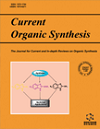- Home
- A-Z Publications
- Current Organic Synthesis
- Previous Issues
- Volume 13, Issue 2, 2016
Current Organic Synthesis - Volume 13, Issue 2, 2016
Volume 13, Issue 2, 2016
-
-
The Povarov Reaction as a Versatile Strategy for the Preparation of 1, 2, 3, 4-Tetrahydroquinoline Derivatives: An Overview
More LessAuthors: Josue S. Bello Forero, Joel Jones Junior and Flavia M. da SilvaTetrahydroquinoline (THQ) subunits are present in many natural products and biologically active agents, such as anti-viral, anti-biotic, and anti-tumour medications. The synthesis of THQs is described extensively in literature due to the search for a general, simple, efficient and low-cost preparation method. The retrosynthetic analysis for THQ synthesis has many strategies involving the formation of one or two C-C or C-N Read More
-
-
-
Carbohydrate-Based Organocatalysts: Recent Developments and Future Perspectives
More LessAuthors: Amrita Mishra, Nidhi Mishra and Vinod K. TiwariOrganocatalysts are small organic molecules that accelerate a reaction when used in sub-stoichiometric amounts. Their utility in various synthetically useful transformations have increased enormously in the past decade. Representing a link between two major forms of catalysis: metal complex mediated catalysis and enzymatic catalysis, the term ‘organocatalysis’ establishes connectivity between synthetic and bi Read More
-
-
-
Recent Advances in Application of Pyridinium Chlorochromate (PCC) in Organic Synthesis
More LessAuthors: Majid M. Heravi, Azadeh Fazeli and Zeinab FaghihiPyridinium chlorochromate (PCC) is an important reagent in organic synthesis used primarily for the selective oxidation of alcohols to give carbonyl compounds. Although a variety of related compounds are known with similar reactivity, PCC offers exclusively the advantage of the selective oxidation of alcohols to aldehydes, whereas many other reagents were less selective. Disadvantages of using PCC are the tedious reacti Read More
-
-
-
Hydrogenations and Deuterium Labeling with Aluminum-based Metal Alloys Under Aqueous Conditions
More LessAuthors: Hyejin Cho, Christian Schäfer and Bela TörökAdvances in the application of aluminum-based metal alloys in the hydrogenation as well as deuteration of a broad range of organic compounds are reviewed. The use of the Al-based alloys allows, and in fact favors, the reaction to be carried out in aqueous medium, which is a major step forward for reduction reactions given the recent need for environmentally benign reaction design. The Al content of the alloy, used as r Read More
-
-
-
Convergent Synthesis Strategy of Novel Fused Azines: 1H-15N HMBC NMR as a Tool for Assertion of the Site Selectivity of Aza-Michael Addition Reaction
More LessAuthors: Tamer S. Saleh, Ahmed E. M. Mekky and Abdullah S. Al-BogamiA unified convergent strategy has been developed for the facile synthesis of a series of novel fused azines bearing a phenothiazine moiety based on the aza-Michael addition reaction of an enaminone derivative to a variety of different heterocyclic amines under microwave irradiation conditions. The results of this study revealed that new methods are required to allow for the simple and efficient analysis of the fused az Read More
-
-
-
2, 7-Diarylidene-cycloheptanone, Hydrazonoyl Chlorides and Heterocyclic Amines as Precursors for Synthesis of Bioactive new Fused Cycloheptapyrimidine Derivatives
More LessAuthors: Thoraya A. Farghaly, Magda A. Abdallah and Zeinab A. MuhammadA series of novel cyclohepta[1,2-d][1,2,4]triazolo[4,3-a]pyrimidines was prepared by reaction of 9- arylmethylene-cycloheptapyrimidine-2-thione with hydrazonoyl halides in dioxane in the presence of triethylamine. Also, a series of fused cycloheptapyrimidines was synthesized via reaction of 2,7-diarylmethylenecycloheptanone with heterocyclic amines. The products 14a-c of the latter reaction were used as starting materials Read More
-
-
-
Aci-Quinone Compounds from Eugenoxyacetic Acid and Methyleugenol: Preparation and Reaction
More LessAuthors: Nguyen Huu Dinha, Nguyen Hien, Nguyen Thi Ngoc Mai and Duong Quoc HoanA new aci-quinone compound, 4-(aci-nitro)-2-(methoxy)-5-(3-nitro-2-(nitrooxy)propyl)-cyclohexa-2,5- dienone (2), an analog to 4-(aci-nitro)-2-(carboxymethoxy)-5-(3-nitro-2-(nitrooxy)propyl)-cyclohexa-2,5-dienone (1), was successfully synthesized and fully characterized by spectroscopic methods. The reactions of 1 and 2 with various reagents such as hydroxylamine, acetic anhydride, semicarbazide and thiosemicarbazid Read More
-
Volumes & issues
-
Volume 22 (2025)
-
Volume 21 (2024)
-
Volume 20 (2023)
-
Volume 19 (2022)
-
Volume 18 (2021)
-
Volume 17 (2020)
-
Volume 16 (2019)
-
Volume 15 (2018)
-
Volume 14 (2017)
-
Volume 13 (2016)
-
Volume 12 (2015)
-
Volume 11 (2014)
-
Volume 10 (2013)
-
Volume 9 (2012)
-
Volume 8 (2011)
-
Volume 7 (2010)
-
Volume 6 (2009)
-
Volume 5 (2008)
-
Volume 4 (2007)
-
Volume 3 (2006)
-
Volume 2 (2005)
-
Volume 1 (2004)
Most Read This Month
Article
content/journals/cos
Journal
10
5
false
en


